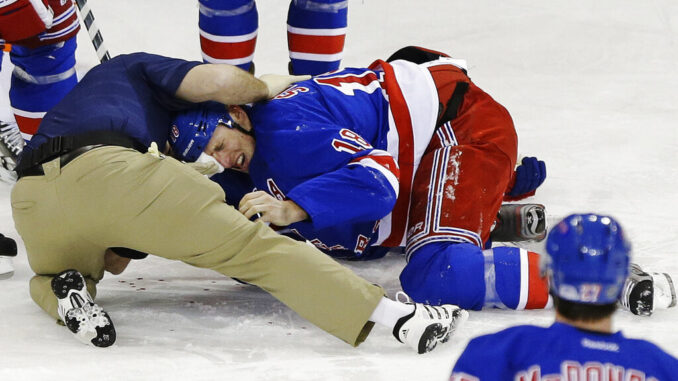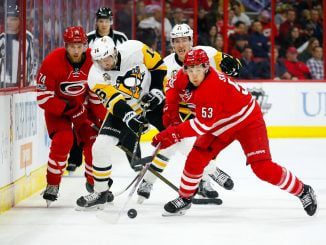
MORRISVILLE — The hockey world turned its eyes and hearts to a place it usually doesn’t this weekend — to England, where former NHL player Adam Johnson died after an on-ice collision in a game that resulted in his throat being slashed.
The 29-year-old had joined the Nottingham Panthers of the Elite Ice Hockey League after spending last season in Germany. Johnson, a native Minnesotan who went to college at Minnesota-Duluth from 2015-17, had previously played 13 NHL games over two seasons with the Pittsburgh Penguins in 2019, spent parts of five seasons in the American Hockey League, and played briefly in Sweden.
Hurricanes defenseman Brady Skjei played at Lakeville North High School south of Minneapolis against Johnson and his brother Ryan, who both played for Hibbing/Chisholm in the northern part of the state. Skjei remembered the Johnsons as “good players” and called Adam’s death “a tragedy.”
It’s the latest reminder of what can go wrong on the ice — and the equipment players have available to them that often goes unused.
Hurricanes captain Jordan Staal and his two brothers were among the NHL players who did not wear a helmet shield upon entering the league. That changed when middle brother Marc suffered an eye injury in 2013 after he was struck with a puck while playing with the Rangers. The injury changed the trajectory of Marc’s career — though the 36-year-old is still playing, spending his first season with the Flyers in his 17th season — and the brothers’ position on eye protection.
“I’ve had someone extremely close to me go through something that you never want to see anyone go through,” Eric Staal, then the captain of the Hurricanes, told the media when he and brother Jordan put on visors following their brother’s injury.
“Safe to say that the family is happy we are doing it,” Jordan added.
Visors became mandatory in the NHL a few months after Marc Staal’s injury, though some veteran players were grandfathered in and continue to play without one.
“Back when they put the visors in, nobody was wearing them,” Hurricanes coach Rod Brind’Amour said of visors starting to appear around the league during his playing days. “I remember I almost had my eye taken out and I tried a visor for seven games, and I just got rid of it.”
Johnson’s death has brought attention specifically to neck protection, something most youth hockey players wear today. While the NHL hasn’t yet mandated neck guards or similar equipment, it wouldn’t be surprising to see the league take some sort of action.
Last season, Oilers forward Evander Kane had one of his wrists cut by a skate during a game against the Lightning, a scary incident that saw a panicked Kane race to the bench as blood trailed behind him on the ice.
Two members of the Hurricanes’ staff said the NHL sent a memo last season following Kane’s injury telling teams to have wrist guards available in case any players wished to begin wearing them for protection.
Carolina head athletic trainer Doug Bennett has seen the danger skates can present firsthand. While there have been a handful of skate cuts to Hurricanes players over the years, they were nothing like what happened to Jets defenseman Zach Redmond in 2013.
While participating in the morning skate at PNC Arena before Winnipeg’s game in Raleigh on Feb. 21, 2013, a teammate stepped on the back of Redmond’s leg above his knee, causing a “fairly wide cut.”
Bennett said a Hurricanes player — clearly not understanding the severity of the situation — nonchalantly told him a Jets player had suffered a cut on the ice. When Bennett came out of the tunnel, he saw a pool of blood under Redmond and immediately called 911.
Redmond was taken by ambulance to the hospital and fortunately didn’t suffer a worse fate. Redmond returned to PNC Arena in November 2014, having moved on to the Avalanche. “The guy scored a game-winning goal against us,” Bennett said with a smile. It was the only game-winning goal of Redmond’s 133-game NHL career.
While the injuries suffered by both Redmond and Johnson were deemed “freak accidents,” players have slowly adopted more protective equipment. Kevlar socks are widely used by NHL players to prevent leg cuts, and there has already been a wave of interest around the league in neck protection following Johnson’s death.
Unfortunately, many players are slow to adapt, saying protective equipment is uncomfortable or hinders their play. The change often comes gradually, with youth players wearing the latest safety gear from the moment they lace up their skates and bring it with them as they advance up the ranks.
“You see now, the kids would come up with them and they don’t even talk about it,” Brind’Amour said. “It’s the same thing with these kinds of extra safety measures with the equipment. If you wear them growing up, then it becomes normal. So you’ve really got to start at the grassroots and make sure they keep wearing them.”
The Hurricanes’ game Monday in Philadelphia still offered a reminder of how safety isn’t always a priority. Carolina winger Jordan Martinook was helped off the ice after he was bloodied when a puck hit in the mouth in the third period of the team’s win over the Flyers.
No NHL forwards or defensemen wear full facial protection.



